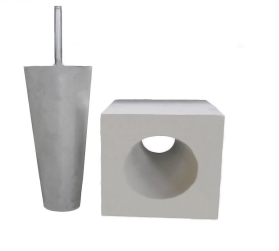- 26
- Sep
Bottom argon blowing process analysis: requirements for the position and performance of the air-permeable brick
Bottom argon blowing process analysis: requirements for the position and performance of the air-permeable brick

Split Breathable Brick
The places that need to be paid attention to during the use of breathable bricks are the location requirements of the breathable bricks and the performance required for anti-corrosion.
Location requirements for breathable bricks
The bottom edge of the bag, the center of the bag bottom and the radius of the bag bottom are the common positions of bottom-blown argon-permeable bricks.
According to experimental observations, when the air-permeable brick is at the edge of the bottom of the bag, the molten steel does not produce swirling flow and there will be dead corners because the gas cannot be stirred. In addition, the damage of the cladding wall lining in the entire package was eccentric damage to the center of the package, and the upper part of the air-permeable brick was seriously damaged and corroded by molten steel. Practice shows that this position is unreasonable.
When the air-permeable bricks are placed between the radius of the bottom of the package and multiplied by 0.37-0.5, although there is some eccentricity in the agitation of the air-permeable bricks, the agitation of the molten steel has been greatly improved, and compared to the wall lining The damage is more even.
Thermal shock of breathable brick
In static molten steel, due to the melting point, the chemical properties are in a stable state, so it is less affected by corrosion. However, during the process of argon blowing, argon overflows from the slits of the air-permeable bricks, squeezed by the static pressure of the molten steel at the slit mouth, and shearing of the surrounding molten steel will form complete bubbles. This instability results in the formation of complete bubbles. Intensified the reduction of the life of the breathable brick. Therefore, the thermal shock of the breathable brick must stand the test. Observation shows that after using 20-30 times of non-refining ventilating bricks, the residual thickness is seriously lower than the thickness of the bottom of the ladle, and the service life cannot be equal to the life of the ladle, let alone refining.
Permeability resistance of permeable brick slits
Breathable bricks are divided into dispersive, slit type and directional type. Experimental observations show that after the ventilating brick is used, steel sheets are generally infiltrated and condensed in the slits. This is because when the bottom blowing is completed, the gas chamber of the ventilating brick communicates with the outside atmosphere, and the molten steel infiltrates into the gap and solidifies under high static pressure. , Which makes the blow-open rate of the breathable brick seriously drop.
in conclusion
If you want to extend the service life of ventilating bricks, you must pay attention to the location of the ventilating bricks, and you must choose products with strong thermal shock and permeability resistance when choosing ventilating bricks.
